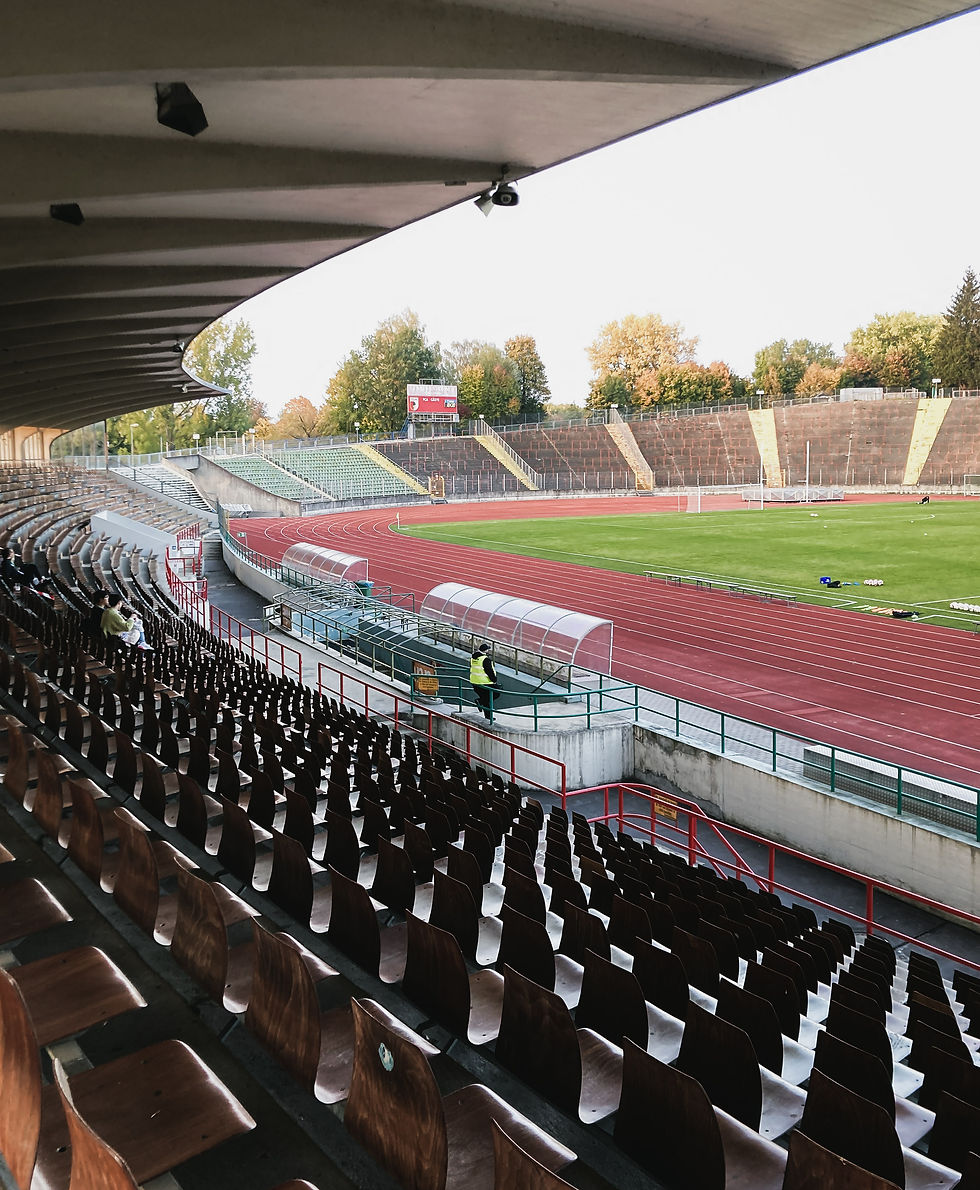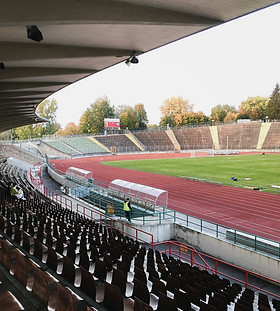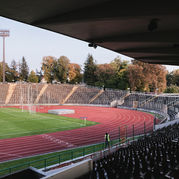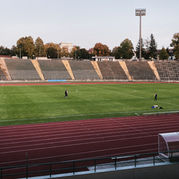
FC AUGSBURG II
AUGUST 2025
Founded: Aug 8, 1907
Club Members: 24,435
Nickname: Fuggerstädter
Coach: Markus Feulner
Captain: Hendrik Hofgärtner
Bezirksliga Schwaben-Nord: 1
Bezirksoberliga Schwaben: 1
Schwäbischer Pokal: 1
Website: www.fcaugsburg.de
FC Augsburg II can trace their roots back to the pre-merger 'BC Augsburg Amateure' whose high-water mark came in 1963 when a sixth-place finish in the Amateurliga Bayern-Süd was enough to see them benefit from a league restructure and qualify for the unified Amateurliga Bayern division - at the time, the highest amateur league in the region. Mirroring the decline of BCA's senior side however, a despondent season saw Amateure crash back into the fourth-tier Landesliga just a year later as BCA officials met with their counterparts at another Augsburg club - TSV 1847 Schwaben Augsburg - to discuss the possibility of a merger. A proposal to merge the two clubs had actually been discussed back in the late 1940s but quickly rejected after neither side could come to an agreement about how it would all work. On 15th July 1969 however, with BCA and TSV continuing to struggle in the amateur ranks and the beleaguered finances of both clubs adding extra urgency to the need for a solution, a union was finally agreed with the new club becoming known as 'FC Augsburg'.
With just a few hundred fans keeping the turnstiles turning each game, it took some time for FC Augsburg's senior side to be fully embraced by the city and even longer for people to come around to the idea of spending their time watching the reserves (Amateure) whose early record was largely unremarkable. Much of it was spent in the lower leagues before bouncing between the Bezirksliga Schwaben-Nord and Landesliga Bayern-Süd for a period in the mid 1970s. In a throwback to the more successful days of BC Augsburg however, Amateure showed some cup pedigree by qualifying for the DFB-Pokal after lifting the Schwaben Cup in 1977 and they knocked out Arminia Hannover and amateur side 1.FC Normannia Gmünd before Bundesliga heavyweights Hertha BSC beat them 4-0 in the third round - the same stage that saw Augsburg's senior side also dumped out of the competition by fellow Bavarians TSV 1860 München.
After becoming a founding member of the Bezirksoberliga Schwaben division in 1988, Amateure were disbanded at the end of the season and didn't reform until 2004 when they returned action in the then fifth-tier Landesliga Bayern-Süd. A year later came an instruction from the DFL (German Football League) that all reserve teams of Bundesliga clubs had to replace 'Amateure ' with the roman numeral 'II', and as 'FC Augsburg II', after several seasons of middle-order ranking that included a spell under future 1.FSV Mainz 05, Borussia Dortmund, PSG and Chelsea manager Thomas Tuchel, the second team of the Fuggerstädter won promotion to the Regionalliga Bayern in 2012 after holding off the challenge of SB/DJK Rosenheim and FC Schweinfurt 05 in a play-off.


GROUND DETAILS
Ground Name: Rosenaustadion
Architect: Thomas Wechs
Construction Costs: DM 1.1 - 1.8m
Built: 1949 - 1951
Year Opened: 1951
Renovations: 1955, 1971, 2006 - 2007, 2014
Capacity: 28,000
Record Attendance: 64,586 (1952)
Undersoil Heating: Yes
Running Track: Yes
Floodlights: 1,400 lux
LED Video Screen: 48m²
Playing Surface: Natural Grass
Pitch Size: 105m x 70m







Named after the land on which it's built and one of the most historic grounds in Germany, the Rosenaustadion rose from the ashes of World War 2 after allied bombing raids targeting the nearby Messerschmitt aircraft factory left much of Augsburg in ruins.
As the nation struggled to recover from the effects of war and Nazi rule, a temporary narrow-gauge railway was used to clear over 185,000 tonnes of Trümmer (rubble) from the shattered city centre and dump it on the Rosenau floodplain along the banks of the Wertach river. The idea was to recycle as much as possible and sell it on for building material, but a general lack of manpower and money immediately after the conflict dampened demand. With city authorities keen to remove the mountain of debris silhouetted against the skyline, thoughts turned towards building a stadium on the site using plans originally drawn up in 1926 by a local architect called Thomas Wechs.
Wech's design was similar to the recently opened Olympic Stadium in Helsinki and, because it steered away from the intimidating ostentatious architecture of the National Socialist era, the project was quickly approved with construction getting underway in 1949. The work was initially carried out in secret however because local support for the development was lukewarm at best, with many residents believing that scarce resources in post-war Augsburg should have been used to build housing and schools instead of a new sports stadium. The authorities pressed on regardless however and 51,000 people were at the Rosenau to watch a 'B' international between Germany and Austria when it opened on the 16th September 1951. With its multi-sport design and a capacity of 70,000, it was widely acknowledged as one of the best stadiums in the country with former IOC vice -president Willi Daume declaring "The post-war development of German sport is inconceivable without the Rosenaustadion ".
It was the first stadium to be built in post-war Germany, and to save on construction costs - which, even at an estimated DM 1.1 to 1.8 million, were modest for the time - three sides of the oval-shaped bowl were set against banks of war rubble, into which steps were cut and faced with black tar boards to create a continuous sweep of open terracing. A covered all-seater, single-tiered grandstand along the western side remains the Rosenau's only 'true' engineered building and a running track around the perimeter sets the ends behind each goal a fair distance from the action.
Floodlights were switched on for the first time during the 1950s before the terraces were recast with concrete after fans complained about the state of their shoes - not to mention the health hazards associated with exposure to polycyclic aromatic hydrocarbons - from standing on tar boards. Further development then saw three banks of wooden benches (later replaced with plastic seat shells) added to the Gegengerade before the original cinder running track was given an all-weather surface in 1971.
Up until this point, the Rosenau had been one of the country's flagship stadiums and its sporting duality saw major football and athletics events held here. On 9th November 1952, the foundations for West Germany's 'Miracle of Bern' triumph were laid when no fewer than eight of the side that would lift the World Cup two years later were involved in a 5-1 win over Switzerland with temporary tubular steel stands built to accommodate a stadium record crowd of 64,586. FC Bayern München won the first of their 82 (and counting !) trophies here when they beat Fortuna Düsseldorf 1-0 in the 1957 DFB-Pokal final. And, in 1958, 85,000 bore witness over two days to "the second greatest miracle in German sports history..." when Ludwig Müller scored victories over 5,000 and 10,000 metres in an athletics international against the USSR.
The Rosenau's days as the region's premier sports stadium were numbered however when Munich's showpiece venue - the Olympiastadion - opened on 26th April 1972 and although it hosted four matches during the Olympic Games football tournament, it had lost its raison d'être and became locked in a sad, sedate decline.
It wasn't until FC Augsburg finally ended a 23-year exile from Bundesliga 2 in 2006 that the stadium was given an extensive revamp which saw the floodlights upgraded, a new manual scoreboard added to the northern end of the ground and a public address system installed in the Haupttribüne (main stand). To comply with DFB stadium regulations, 1,500 standing places were also replaced with 600 seats in the Gäste Block (Guest Block) which reduced the overall capacity to 31,354 although the official limit was, and still is, set at 28,000 on safety grounds. The overhaul continued over the next few months with additional ticket offices and a new stadium clock, before €400,000 was spent on undersoil heating - the first time that the playing surface had been replaced in over 50 years.
Despite the renovations however, the Rosenau's oval-terraced layout remains virtually unchanged since the day it opened and the end result is both its appeal and undoing. It was obvious that the stadium wasn't going to be able to keep pace with the demands of modern football with a groundswell of opinion highlighting the ageing infrastructure, high maintenance costs and a lack of development opportunities. After exploring relocation options since the early 2000s, planning approval for a new 30,000 capacity venue next to the B17 motorway south of the city was granted and, on 26th July 2009, FC Augsburg's senior side moved into the SGL Arena (later renamed WWK Arena) - leaving the Rosenaustadion with an uncertain future.
The stadium still plays host to FC Augsburg II and local school sports events but now that large crowds have come and gone, the Rosenau is catering for a lost era with large sections of the terraces closed off on safety grounds. There's been open discussion about what to do with the crumbling stadium and the original plan was to demolish it and sell the site to developers before it was 'saved', ironically, by its legacy as a former dump for war debris and the costs involved with cleaning up the contaminated land. The ground was granted listed status in 2014 which protected it from wholesale demolition and the latest in a long line of proposals is to convert the main stand into apartments whilst retaining its façade, and create a parkland in which the rest of the stadium will form what has been described as a 'walk-in sculpture'.
Whatever the future holds, one thing is certain - football may have changed over the years but the Rosenaustadion hasn't and, for the time being at least, there's enough character here to witness a fascinating past, rather than just having to imagine it.
BUYING TICKETS
Average Attendance:
2024-2025: 470 (Regionalliga Bayern)
2023-2024: 401 (Regionalliga Bayern)
2022-2023: 383 (Regionalliga Bayern)
2021-2022: 360 (Regionalliga Bayern) *
2020-2021: 335 (Regionalliga Bayern) *
* Season affected by COVID pandemic
Expected Ticket Availability
FC Augsburg sell tickets in advance for the Under-23s through their online shop (here) but with only Regionalliga football on offer and the Rosenaustadion boasting a capacity on par with the WWK Arena across town, there's no need for a mad scramble. You can just turn up at the ticket window behind the Rosenaugastätte outside the ground about an hour before kick-off.
The (very) healthy gap between ticket supply and demand means that only the main stand will be open and damage on the wallet is limited to €8 for adults with students, seniors, disabled persons, those 'in between jobs' etc paying €5. Children (aged 6-13 years) will have to give up €1 of their pocket money and even younger people are let in free of charge.
GETTING THERE & AWAY
Stadium Address:
Stadionstraße 21
86159 Augsburg

BY CAR:
If you're coming by car, the simplest advice is to put the stadium address in your Sat-Nav and follow its guidance. There are a few car parks where Stadionstraße becomes Gabelsberger Straße
(Gabelsbergerstraße 64, 86199 Augsburg ) right across the road from the stadium, and at the Sporthalle Erhard Wunderlich on Ulrich Hofmaier Straße (Ulrich-Hofmaier-Straße 30, 86159 Augsburg).
PUBLIC TRANSPORT:
As per usual in the lower leagues, match tickets are not valid for use on Augsburg's public transport network.
From Königsplatz in the city centre, Tram 1 (Direction: Göggingen) takes 3 minutes to reach the Polizeipräsidium stop, from where it's a 10-minute walk along Ulrich Hofmaier Straße and through Wittelsbacher Park to the turnstiles. If you've arrived at Augsburg HBF, then Bus 32 (Direction: Augsburg Uniklinik BKH) leaves from stand L in front of the InterCityHotel and will drop you off a couple of minutes later at Luitpoldbrücke. It's then just a matter of keeping the Wertach river on your right hand side for the 15-minute walk along Perzheimstraße and Stadionstraße to the Rosenaustadion.
WALKING DIRECTIONS:
It's quite straightforward to reach the Rosenaustadion on foot and it'll take you 20 minutes to stroll over from the Hauptbahnhof. Come out of the main station entrance, turn left and head onto Viktoriastraße. At the junction, turn left onto Frölichstraße and follow it under the railway bridge as it becomes Pferseer Straße. Keep going along Pferseer Straße until you reach the Luitpoldbrücke bridge over the Wertach river. Turn left and follow Perzheimstraße as it becomes Stadionstraße directly to the stadium.
FAN SHOP, MUSEUM & STADIUM TOURS

FAN SHOP:
There isn't so much as a merchandise table at the Rosenaustadion on a matchday but the full range of Függerstädter souveniers can be picked up either at the WWK ARENA or at the fanshop on Maximilianstraße in the centre of Augsburg.
Fanshop am Stadion
(WWK ARENA, Bürgermeister Ulrich Straße 90, 86199 Augsburg; 9:30am-6pm, Mon-Thu; 9:30am-3:30pm, Fri; open on matchdays 3.5 hours before kick-off until one hour after full-time; tel: +49 (0) 821 650400).
Fanshop Maxstraße:
(Maximilianstraße 9, 86150 Augsburg;10am-7pm, Mon-Sat; tel: +49 (0) 821 65040800)
FOOD & DRINK OPTIONS

With Augsburg's attractive centre of spires and cobbles only a corner kick away, most fans head to the bars and restaurants there before making their way to the match.
At the stadium itself, a kiosk sets up behind the Haupttribüne (main stand) so that you can watch the action with a few pints of beer and a wurst or two from the griddle; and you won't be surprised to learn that unlike at the WWK ARENA, everything can be paid for here in cash. Less straightforward though is the process of ordering food and drink. This is how it's done: Tell the server stood at a table to the right of the kiosk what you'd like and, after paying, he/she will give you a receipt. You then hand this over to one of the kiosk staff and they'll put your order together.
There's a stadium restaurant called the Rosenaugastätte which served as a VIP area before FC Augsburg moved to the WWK ARENA in 2009 but following a major renovation in 2022, it no longer caters for football fans. Today, its doors are only opened for wedding guests and conference delegates - which did make us wonder what was going on when people began arriving in ballgowns and statement tuxedos about an hour before kick-off on our visit.
OTHER CLUBS IN THE AREA
BUNDESLIGA: FC Augsburg, FC Bayern München
BUNDESLIGA 2: 1.FC Nürnberg, SpVgg Greuther Fürth
3.LIGA: FC Ingolstadt 04, SSV Jahn Regensburg, TSV 1860 München



























